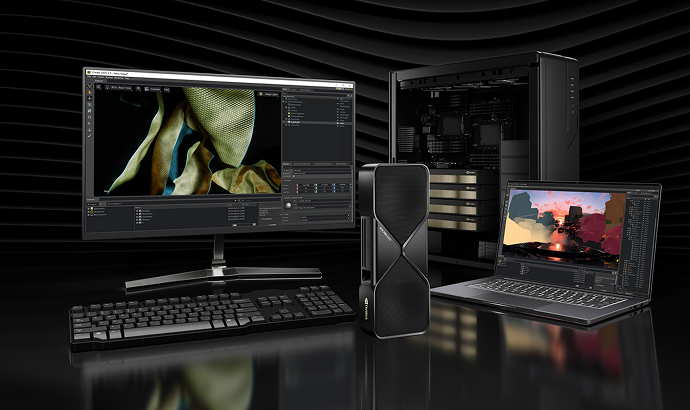

Writing About AI
Uvation
Reen Singh is an engineer and a technologist with a diverse background spanning software, hardware, aerospace, defense, and cybersecurity. As CTO at Uvation, he leverages his extensive experience to lead the company’s technological innovation and development.

The NVIDIA GeForce RTX 5090 is not just a new graphics card, but rather a groundbreaking innovation poised to redefine visual computing. It is designed to obliterate existing boundaries in gaming and professional applications, bringing previously impossible visual experiences into the routine. Its significance lies in its transformative AI-powered upscaling (DLSS 4 Multi Frame Generation) and real-time ray tracing capabilities, which promise to make digital worlds palpably real and offer significant latency reductions for competitive gamers.
The RTX 5090 represents a significant evolutionary step from the RTX 4090, building on NVIDIA’s Ada Lovelace architecture. While the RTX 4090 was powerful, it highlighted areas for improvement in power efficiency and thermal design. The RTX 5090 addresses these by aiming for a more efficient and balanced approach to performance, featuring refined transistor layouts and smarter power management. It is projected to offer a 20% to 50% performance uplift in 4K gaming, potentially boasting over 18,000 CUDA cores and up to 48GB of GDDR7 memory.
The RTX 5090 incorporates several cutting-edge technological innovations. It features new, more powerful ray-tracing cores for unprecedented realism in lighting, shadows, and reflections, enabling more intricate and dynamic environments. Furthermore, it is anticipated to introduce DLSS 4.0, which will use advanced AI to upscale images, improving quality and performance. Beyond DLSS, the RTX 5090 is expected to harness AI for new functionalities like noise cancellation and real-time content generation, enhancing both gaming and professional workflows.
The RTX 5090 is projected to redefine gaming performance, especially in modern AAA titles. Gamers can anticipate seamless gameplay at the highest settings, with the card maintaining over 100 FPS at 4K resolution. Its enhanced ray-tracing and path-tracing capabilities will deliver breathtakingly realistic lighting and reflections. The RTX 5090 is also tailored for both 4K and 8K gaming, promising ultra-smooth gameplay at 4K and playable frame rates with stunning detail for 8K, making it a forward-looking choice for enthusiasts.
For virtual reality and mixed reality, the RTX 5090 is expected to be a game-changer. Its capacity for high frame rates and low latency is crucial for providing a fluid and immersive VR experience, reducing the likelihood of motion sickness. The card’s robust processing power will support intricate VR worlds and applications, allowing developers to create more interactive and realistic experiences across gaming, educational simulations, and professional applications, significantly expanding the horizons of VR and mixed reality.
The RTX 5090 is positioned to revolutionise cloud gaming platforms like GeForce NOW. Its formidable hardware, including advanced ray tracing and AI enhancements (like DLSS), allows for superior performance and visual fidelity, even when streaming. This enables gamers to enjoy top-tier graphics and responsive gameplay without needing high-end local hardware, as the computational load is managed by RTX 5090-powered servers. This capability, combined with high-speed internet, lowers latency and makes high-quality gaming accessible to a wider audience.
To fully utilise the RTX 5090’s potential, a compatible high-end system is necessary. This includes a powerful CPU, such as the latest Intel Core i9 or AMD Ryzen 9, and a motherboard supporting PCIe 4.0 or higher. A minimum of 32GB of RAM is recommended for multitasking. Due to its anticipated TDP of roughly 500 watts, a power supply unit of at least 1000 watts (preferably 80 Plus Gold or Platinum certified) is crucial. Adequate cooling solutions and a spacious case with good airflow are also essential to manage the heat generated by this high-performance card.
The RTX 5090 is anticipated to be NVIDIA’s flagship product, strategically priced at the high end to target enthusiasts and professionals seeking peak performance. This positioning reinforces NVIDIA’s leadership in the GPU market. Its introduction will drive demand for complementary hardware, spurring innovation across the gaming hardware ecosystem. For game development, the RTX 5090 will set new benchmarks, encouraging developers to leverage its advanced features. Furthermore, by empowering cloud gaming, it broadens market accessibility beyond traditional high-end PC users, reaching a more diverse audience. Its production will also impact the global semiconductor industry, driving investment and innovation in manufacturing processes.
We are writing frequenly. Don’t miss that.

Unregistered User
It seems you are not registered on this platform. Sign up in order to submit a comment.
Sign up now